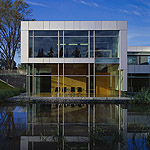Last month, the Kresge Foundation in Troy, MI, announced a new national strategy for its arts and culture programs: fostering the long-term health of cultural institutions.
 It sounds so simple, so non-controversial. What’s the big deal?
It sounds so simple, so non-controversial. What’s the big deal?
The $3.1 billion Kresge is a titan: In 2009, it awarded some $197 million to 404 non-profits. Among the arts beneficiaries: The Public Theater of New York, the Detroit Symphony Orchestra, the Plains Art Museum and the Kansas City Ballet. (Kresge’s LEED-certified HQ is at right.)
But, for too long, the focus throughout the cultural world has been on increasing everything: new buildings, expanded buildings, new programs, etc. etc. Now, as I’ve written before, we probably have too much capacity — maybe not overall, but in various locations. It’s unsustainable, as various closures have proven.
As Kresge said, in an article in Philanthropy News Digest:
“Kresge was a critical player in the twenty-year cultural facility building boom that swept the arts sector,” said Kresge arts and culture program director Alice L. Carle. “But numerous signs suggest that the building boom is over, halted by a combination of the economic recession and the staggering challenges of running capital campaigns and then covering steadily rising fixed costs. Our new grantmaking strategy is designed to assist organizations in successfully making this transition and positioning themselves for long-term sustainability.”
Kresge’s Arts and Culture program now has new standards, a new policy, communicated in this equation:
Well-capitalized cultural institutions + Well-resourced artists + Well-integrated arts and community building = Strong, vibrant cities, towns and communities.
Indeed, it says on its website: “The Arts and Culture Program will no longer consider traditional facilities-capital challenge grant applications. All requests for facilities funding must be made through Institutional Capitalization as outlined above.”
I’m coming to the “outlined above,” but first I have to say hooray.
Back to Institutional Capitalization:
Kresge says it will look at the strength of an organization’s balance sheet, and try to get grantees to address their financial footing while building, not after. Organizations may apply for these kinds of grants (underlining is mine):
Facility investments grants support both project costs and the creation of a building reserve. This new grant opportunity will prioritize renovation and repair projects. On occasion, we will entertain applications for new construction associated with exemplary sustainability practices or those that embody key principles of urban and community planning to enhance the quality of life in a place.
Building reserves grants are designed to seed or enhance a fund to support the ongoing maintenance and replacement needs of an organization over time.
Further details are here.
The other new elements of Kresge’s strategy are called Artists Support Services and Arts and Community Building. They, too, have some potential to change arts-funding.
But it’s the financial part that I find most encouraging. Other foundations, of course, look at financial stability. As I recall, the Pew Charitable Trusts made financial responsibility a condition of grants some years ago. There may others.
Maybe, just maybe, there’s something in the Kresge program that won’t work so well — so what? Foundations are supposed to experiment, and to facilitate experiments by others.
But maybe, too, if more funders paid attention to financial stability, we wouldn’t have the closures, the deaccessions, the deep cutbacks and other problems we’ve seen in the last two years.
